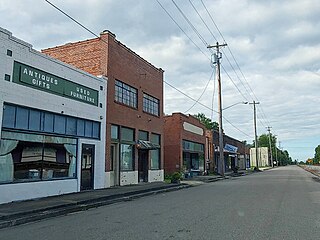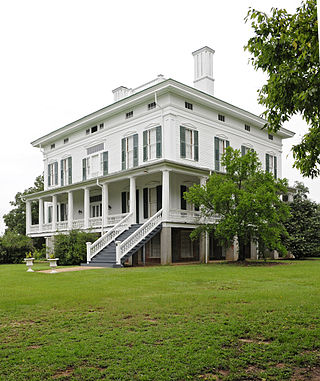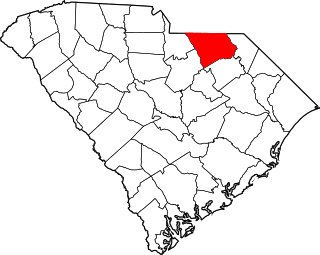Related Research Articles

St. Stephen is a town in Berkeley County, South Carolina, United States. The population was 1,697 at the 2010 census.

This is a list of the properties and historic districts in each of the 46 counties of South Carolina that are designated National Register of Historic Places.

Redcliffe Plantation State Historic Site is a state park in South Carolina, United States. Redcliffe Plantation, also known as Redcliffe, completed in 1859, is a Greek Revival plantation house located on the site that is listed on the National Register of Historic Places. The house was designed by the baron Louis Berckmans and was built in 1857. It was built for James Henry Hammond and was home to three generations of his descendants. His great-grandson John Shaw Billings, editor of Time, Life, and Fortune magazines, donated the estate and collections to the people of South Carolina in 1973. The same year it was added to the National Register of Historic Places.

Hanover House is a colonial house built by a French Huguenot family in 1714–1716, on the upper Cooper River in present-day Berkeley County of the South Carolina Low Country. The house is also known as the St. Julien-Ravenel House after its early owners.

This is a list of the National Register of Historic Places listings in Berkeley County, South Carolina.

This is a list of the National Register of Historic Places listings in Florence County, South Carolina.

Strawberry Chapel is a parochial chapel of ease in the lower part of St. John's, Berkeley Parish in Berkeley County, South Carolina that was built in 1725. It is on Strawberry Chapel Road between South Carolina State Highway 8-44 and the West Branch of the Cooper River. Bordering Strawberry's property is the South Carolina State owned historic site of the “Town of Childsbury.” It was a planned community that was settled in 1707. The town no longer exists. They were named to the National Register of Historic Places on April 26, 1972.

This is a list of the National Register of Historic Places listings in Chesterfield County, South Carolina.

This is a list of the National Register of Historic Places listings in Jasper County, South Carolina.
Keller Site may refer to:

White Church, also known as The Brick Church, and formally as St. Thomas Episcopal Church and St. Thomas and St. Dennis Parish Church, is a historic church north of Cainhoy in Berkeley County, South Carolina.

Cross is an unincorporated community located in rural northwestern Berkeley County, South Carolina, United States. It is centered at the junctions of South Carolina Highway 6 and South Carolina Highway 45. The zip code for Cross is 29436.

Rivers Bridge State Historic Site, also known as Rivers Bridge State Park, located near Ehrhardt, a small town in Bamberg County, South Carolina, is the site of an important Civil War battle. It is in this area that General William T. Sherman engaged the Confederate Army on his advance from Savannah, and after two days of battle, outflanked the Confederates and forced them to withdraw. River Bridge State Park was listed in the National Register of Historic Places on February 23, 1972.
The Keller Site is a prehistoric ceremonial center located on a former plantation property in Calhoun County, Arkansas. It consists of a group of burial mounds that were apparently first established by the Coles Creek culture, and the area also saw use in the Caddoan period, c. 1200AD. The site was partially excavated in 1909 by Clarence B. Moore. The site, which was listed on the National Register of Historic Places in 1979, is primarily notable because it is relatively undisturbed, providing the potential for further fruitful research.
Otranto Plantation Indigo Vats are historic indigo vats located near Goose Creek, Berkeley County, South Carolina. Indigo vats are where fermentation and settlement processes for production of indigo dyestuff were accomplished. Each vat measures approximately 14 feet square and has a stuccoed interior. The upper vat, known as the "steeper vat", was used for the fermentation of indigo plants with the liquor drawn through a small portal into the "beater vat" below. The liquor was agitated, allowed to settle, and the remaining sludge strained, molded into cakes, and dried. The Otranto Plantation Indigo Vats were relocated by the Verona Chemical Company, later Mobay Corporation, from Otranto Plantation to their present site in 1979 to save them from demolition. They are the only such structures know to be in existence in South Carolina.
Cainhoy Historic District is a national historic district located near Huger, Berkeley County, South Carolina. It encompasses nine contributing buildings, which range in date from the mid-18th century through the early-20th century. They represent the development of the village from a ferry landing to a small but thriving river port. It was the site of America's first porcelain factory, established by John Bartlam in 1765. Each building is a vernacular specimen from its respective period, including the Federal style. Cainhoy's significance lies in its role as an early transportation link between inland Berkeley County and Charleston and in its fine collection of early buildings. In 1876, Cainhoy was the site of a political rally for Wade Hampton (1818-1902) which degenerated into a brawl between blacks and whites. Christened the "Cainhoy Massacre," the incident left seven men dead and sixteen wounded.
Cooper River Historic District is a national historic district located along the East and West Branches of the Cooper River near Moncks Corner, Berkeley County, South Carolina. It encompasses 32 contributing buildings, 77 contributing sites, 8 contributing structures, and 4 contributing objects and is a remarkably intact historic and cultural landscape. The district includes many historic buildings, structures, and objects from the 18th, 19th, and 20th centuries and archaeological remains of settlements, machines, barns, and other structures that supported agricultural activity. In addition, there are landscape features dating to the 18th and 19th centuries such as rice fields, banks, canals, dams, reservoirs or reserves, causeways, roads, avenues, upland fields, fence lines, and cemeteries.
Blair Mound is a historic archaeological site located near Winnsboro, Fairfield County, South Carolina. Blair Mound is an earthen mound structure in the form of a low, oval hummock. It measures approximately 75 by 50 yards and is just over 5 feet (1.5 m) high, with evidence of leveling for agricultural development.
The Adamson Mounds Site (38KE11) is an archaeological site located near Camden, Kershaw County, South Carolina. It is a prehistoric Native American village site containing one large platform mound, a smaller mound, possibly a third still smaller mound, and a burial area. It served as a regional ceremonial center. This site represents a widespread, late prehistoric Mississippian culture known by the names of Lamar, Irene, or Pee Dee and dates probably between AD 1400 and AD 1700.

Newberry College Historic District is a national historic district located on the campus of Newberry College at Newberry, Newberry County, South Carolina. The district encompasses four contributing buildings and are Smeltzer Hall (1877), Keller Hall (1895), Holland Hall, and Derrick Hall (1925). Smeltzer Hall and Keller Hall reflect the Italianate, and Holland and Derrick Halls reflect the Neo-Classical and Colonial Revival styles.
References
- 1 2 "National Register Information System". National Register of Historic Places . National Park Service. July 9, 2010.
- ↑ "Keller Site, Berkeley County (Address Restricted)". National Register Properties in South Carolina. South Carolina Department of Archives and History. Retrieved February 25, 2014.

